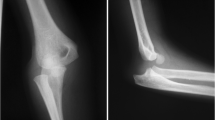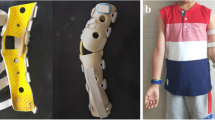Abstract
Purpose
We investigated the functional and radiological outcomes of conservatively treated simple traumatic elbow dislocations and subsequent incidence of cubitus valgus development in children.
Methods
Eleven patients (one female, ten male; mean age 9.8 years, range seven to 12 years) who presented to our hospital with simple elbow dislocations and were conservatively treated between July 2008 and September 2010 were included in the study. All were posterolateral closed dislocations. None of the patients had accompanying elbow fractures. All patients had pre- and postoperative radiographic examinations. The carrying angle of the involved elbow was measured and compared to the contralateral non-injured elbow during follow-up. The incidence and severity of cubitus valgus development was assessed. The functional and clinical outcomes were evaluated using the Mayo Elbow Performance Scale. The mean monitoring period was 24.3 months (range 19–30 months).
Results
All patients had satisfactory good and excellent results (85–100 points; mean 96.8 points) according to the Mayo Elbow Performance Scale. The final average elbow flexion was 137° (range, 130–145°) and average extension was 8.6° (range 0–20°) with full supination and pronation in traumatic elbow. Four patients (36.4 %) had an average increase (cubitus valgus) of 14.5° (10–20°) in carrying angle compared to the other elbow.
Conclusions
While isolated traumatic dislocation of the elbow is uncommon among children, it can be successfully treated by urgent closed reduction, proper fixation of the elbow and appropriate timely rehabilitation. However, it should be considered that some patients may develop cubitus valgus deformity in a later period. Therefore, each patient with a simple traumatic elbow dislocation should be followed, and the parents should be informed of the potential for any deformity development.




Similar content being viewed by others
References
Herring JA (2002) Upper extremity injuries. In: Tachdjian‘s pediatric orthopaedics. Vol. 3, 3rd ed. Philadelphia: W.B. Saundersp. 2191-2194
Park CP, Ahmad CS (2004) Dynamic contributions of the flexor-pronator mass to elbow valgus stability. J Bone Joint Surg 86-A:2268
Wilkins KE (1996) Fractures and dislocations of the elbow region. In: Rockwood CA, Wilkins KE, King RE (eds) Fractures in children 4th, vol 3. Lippincott-Raven, Philadelphia, pp 600–887
Balasubramanian P, Madhuri V, Muliyil J (2006) Carrying angle in children: a normative study. J Pediatr Orthop B 15:37–40
An KN, Chao EY (1993) Functional evaluation of the elbow. In: Morrey BF (ed) The elbow and its disorders, 2nd edn. Saunders, Philadelphia, pp 85–97
Hildebrand KA, Patterson SD, King GJ (1999) Acute elbow dislocations: simple and complex. Orthop Clin North Am 30(1):63–79
Yilmaz E, Karakurt L, Belhan O, Bulut M, Serin E, Avci M (2005) Variation of carrying angle with age, sex, and special reference to side. Orthopedics 28:1360–1363
Spinner RJ, O’Driscoll SW, Davids JR, Goldner RD (1999) Cubitus varus associated with dislocation of both the medial portion of the triceps and the ulnar nerve. J Hand Surg Am 24:718–726
Godfarb CA, Patterson JM, Sutter M, Krauss M, Steffen JA, Galatz L (2012) Elbow radiographic anatomy: measurement techniques and normative data. Shoulder Elbow Surg 21(9):1236–1246
Chein-Wei Chang MD, Yi-Chian Wang MD, Chang-Hung Chu MD (2008) Increased carrying angle is a risk factor for nontraumatic ulnar neuropathy at the elbow. Clin Orthop Relat Res 466:2190–2195
Bulut G, Erken HY, Tan E, Ofluoğlu O, Yıldız M (2005) Treatment of medial epicondyle fracturs accompanying elbow dislocations in children. Acta Orthop Traumatol Turc 39(4):334–340
De Haan J, Schep NW, Zengerink I, van Buijtenen J, Tuinebreijer WE, den Hartog D (2010) Dislocation of the elbow: a retrospective multicentre study of 86 patients. Open Orthop J 17(4):76–79
Durakbasa O, Küçükyazici O, Tuygun H, Okan N, Görgeç M (2003) Surgical treatment of elbow fracture–dislocations seen in children and adolescents. Acta Orthop Traumatol Turc 37(4):304–308
O’Driscoll SW, Morrey BF, Korinek S, An KN (1992) Clin Orthop Relat Res 280:186–197
Jockel CR, Katolik LI, Zelouf DS (2013) Simple medial elbow dislocations: a rare injury at risk for early instability. J Hand Surg Am 38(9):1768–1773
Carlioz H, Abols Y (1984) Posterior dislocation of the elbow in children. J Pediatr Orthop 4(1):8–12
Josefsson PO, Johnell O, Gentz CF (1984) Long-term sequelae of simple dislocation of the elbow. J Bone Joint Surg Am 66(6):927–930
Rasool MN (2004) Dislocations of the elbow in children. J Bone Joint Surg Br 86(7):1050–1058
Michelsson JE, Rauschning W (1983) Pathogenesis of experimental heterotopic bone formation following temporary forcible exercising of immobilized limbs. Clin Orthop Relat Res 176:265–272
De Haan J, Schep NW, Tuinebreijer WE, Patka P, den Hartog D (2009) Simple elbow dislocations: a systematic review of the literature. Arch Orthop Trauma Surg 130:241–249
Mehlhoff TL, Noble PC, Bennett JB, Tullos HS (1988) Simple dislocation of the elbow in the adult. Results after closed treatment. J Bone Joint Surg Am 70(2):244–249
De Haan J, Schep NW, Zengerink I, van Buijtenen J, Tuinereijer WE, den Hartog D (2010) Dislocation of the elbow: a retrospective multicentre study of 86 patients. Open Orthop J 17(4):76–79
Lieber J, Zundel SM, Luithle T, Fuchs J, Kirschner HJ (2012) Acute traumatic posterior elbow dislocation in children. J Pediatr Orthop B 21(5):474–481
Herring JA (2002) Tachdjian’s Pediatric Orthopaedics. Vol 3. 3rd ed. Philadelphia, Pa: WB Saunders Co 2164-2168
Tükenmez M, Demirel H, Perçin S, Tezeren G (2004) Measurement of the carrying angle of the elbow in 2,000 children at ages six and fourteen years. Acta Orthop Traumatol Turc 38(4):274–276
Jain AK, Dhammi IK, Arora A, Singh MP, Luthra JS (2000) Cubitusvarus: problem and solution. Arch Orthop Trauma Surg 120:420–425
Conflict of interest
The authors declare that they have no conflict of interest.
Author information
Authors and Affiliations
Corresponding author
Rights and permissions
About this article
Cite this article
Adaş, M., Bayraktar, M.K., Tonbul, M. et al. The role of simple elbow dislocations in cubitus valgus development in children. International Orthopaedics (SICOT) 38, 797–802 (2014). https://doi.org/10.1007/s00264-013-2199-4
Received:
Accepted:
Published:
Issue Date:
DOI: https://doi.org/10.1007/s00264-013-2199-4




